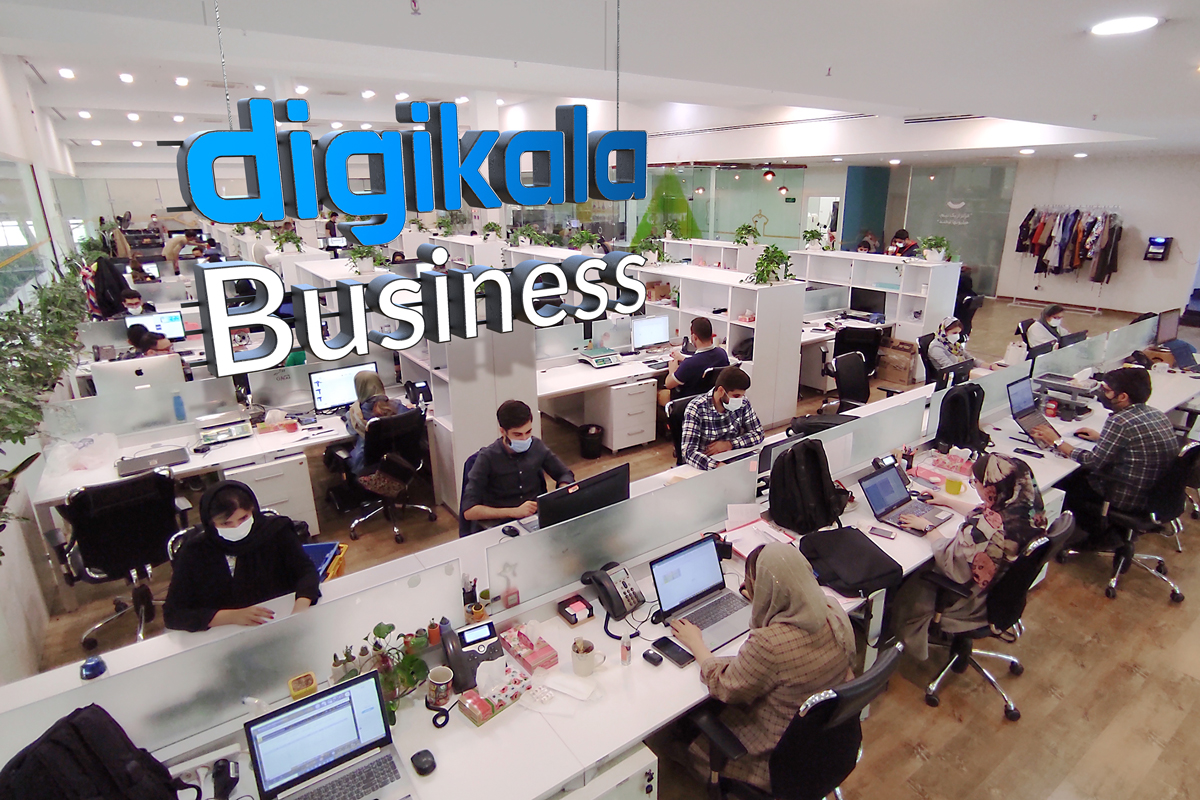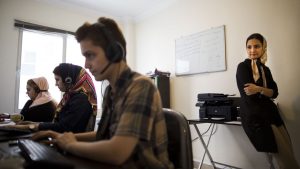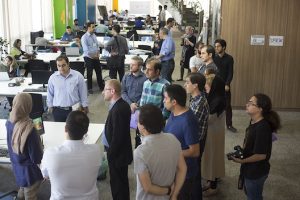Iranian AI Companies
Iran’s Ambition for AI Supremacy—A Resilient Ecosystem Built on Indigenous Innovation
Iran is aggressively positioning itself as a major contender in the global technology arena, underpinned by a National Vision that targets placement among the world’s top 10 AI nations within the next decade. This ambition is not merely rhetorical; the nation already ranks second in the Middle East for its pool of AI developers and fourth for the number of active AI firms, currently boasting over 85 active AI startups.
The foundation of this rapid expansion in iran artificial intelligence is a compelling mix of state support and human capital. The ecosystem is fueled by significant government commitments, including the allocation of approximately $115 million USD for AI research and development in early 2025. This investment, coupled with an exceptional talent pipeline from institutions like Sharif University of Technology and the University of Tehran, ensures a steady stream of highly skilled professionals.
However, the growth trajectory of iran artificial intelligence is unique because it is defined by resilience in the face of significant obstacles. International sanctions severely restrict access to critical resources like advanced GPUs and foreign cloud infrastructure. To maintain “technological sovereignty”, Iranian AI companies and government initiatives have focused heavily on indigenous solutions, including the development of domestic GPU farms and the National Open-Source AI Platform, which provides Persian-language models independent of foreign technology.
This post explores how these Iranian AI companies are driving growth across key sectors—from enhancing medical diagnostics and fraud detection in fintech to developing high-accuracy Persian NLP models—positioning the country as the “Silicon Persia” of the region, despite economic and geopolitical pressures. The projected market size, expected to grow from $5.5 million (2023) to $32 million by 2032, underscores the high-stakes journey of iran artificial intelligence into the global spotlight.
The Accelerated Trajectory of Irani AI: A Market Built on Domestic Mandate
The Irani AI landscape is exhibiting robust expansion, driven primarily by significant government intervention and accelerating digital adoption, presenting a compelling, albeit constrained, investment scenario. While the broader Iran Information and Communications Technology (ICT) market is valued at USD 24.91 billion in 2025, the foundational AI Training Datasets Market—essential for all iran ai development—is projected for explosive growth. This specific segment is forecast to expand from USD 5.54 million in 2023 to USD 32.27 million by 2032, registering a substantial Compound Annual Growth Rate (CAGR) of 21.6% through the forecast period. This growth is anchored by Tehran’s strong commitment, evidenced by a $115 million allocation toward national AI research and development. This funding supports universities, private research centers, and commercialization efforts, establishing a conducive environment for AI applications across critical sectors such as manufacturing, finance, and telecommunications. Furthermore, the rapid expansion of smart city initiatives, such as the Bushehr Smart City Project leveraging AI for traffic management, is fueling a pronounced demand for extensive and diverse training datasets, further solidifying the trajectory of this high-growth technology segment.
The Rise of Local Champions and Customized Solutions
The competitive environment is shifting toward localized expertise, creating distinct opportunities for ai companies in iran. Global giants like Microsoft Corp and Alphabet Inc. maintain a presence, often through their cloud platforms, but the core trend in iran ai development is the imperative for self-sufficiency and localization. Researchers and local firms are prioritizing the creation of localized datasets tailored to Iran’s unique linguistic (Persian language NLP), cultural, and regulatory requirements. While the specific number of ai startups in iran 2025 is not detailed in the sources, the ecosystem is characterized by the emergence of domestic firms and specialized challengers, often spun out of university labs, focusing on low-code platforms and Persian-language NLP to fill gaps left by global vendors. These regional players are leveraging crowdsourcing as a cost-effective method for dataset collection and leveraging domestic GPU-based data centers, which offer scalable resources crucial for developing effective AI models. Investors should note that the success of these local firms hinges on their ability to offer high-quality, customized, and regulatory-compliant AI training datasets, addressing the critical challenge of limited access to diverse, well-annotated data.
Healthtech: A High-Precision Sector Driving Data Specialization
Among the fastest-growing end-user segments, the healthcare vertical stands out, demonstrating advanced sophistication in iran ai development. The demand for high-quality, domain-specific AI training datasets is particularly acute here, with iranian healthtech startups and medical institutions actively creating specialized annotated datasets. This drive is focused on improving AI-driven disease detection and diagnostic accuracy through the analysis of medical imaging and electronic health records. Importantly, to overcome data scarcity and adhere to stringent privacy regulations, the Iranian healthcare sector is increasingly turning to the innovative integration of synthetic data. The use of synthetic patient records allows AI models for diagnostics to be trained effectively without compromising patient confidentiality. This trend highlights not only the strong sectoral commitment to automation and personalized treatment but also the resilience of local developers in finding compliant solutions, positioning healthcare as a leading driver for high-precision, compliant AI investment in the country.
Iran’s Ambitious Rise as an AI Power
Iranian AI companies are spearheading Iran’s rapid ascent as a regional leader in artificial intelligence, underpinned by robust government strategies, academic excellence, and resilient innovation. As of 2025, Iran ranks second in the Middle East for AI developers and fourth for the number of AI firms, boasting over 85 active AI startups. The national vision targets positioning Iran among the world’s top 10 AI nations within the next decade, a goal deemed increasingly feasible by current market forecasts, which highlight the growing influence of Iranian AI companies in global innovation.
National AI Platform and Infrastructure Investments
Iranian AI companies are bolstered by significant 2025 milestones in national AI infrastructure:
- National Open-Source AI Platform (March 2025): Developed by domestic talent, this platform delivers AI services, including Persian language models and analytics, accessible to rural students and urban researchers, promoting technological justice and independence from foreign technology.
- Government Funding: Over $100 million in new investments, plus $115 million earmarked for research, supports Iranian AI companies by enhancing infrastructure, fostering startups, and encouraging public-private collaborations.
- AI-Focused Support Organizations: The National AI Organization, under direct presidential supervision, and plans for a dedicated AI Park in Tehran drive innovation for Iranian AI companies.
- Indigenous GPU Farms: These overcome sanctions-related supply constraints, enabling high-performance AI workloads critical for Iranian AI companies’ scalability.
Key Iranian AI Companies and Startups
Iranian AI companies are diversifying applications across key sectors:
- Language Technologies: AI Root specializes in advanced natural language processing (NLP) and information retrieval for Persian text, while ParsGPT aims to rival global generative AI models for Farsi and local languages, strengthening the global presence of Iranian AI companies.
- Healthcare: Startups deploy AI for medical diagnostics, including home-based infertility detection via image analysis, positioning Iranian AI companies as benchmarks in the health-tech sector.
- Fintech: Iran’s banks leverage AI for risk assessment, fraud detection, and transaction analysis, aligning Iranian AI companies with global financial technology trends.
- Agriculture and Smart Cities: Iranian AI companies harness AI for precision agriculture, smart irrigation, yield prediction, and urban planning, exemplified by the Abbas Abad smart walking path in Tehran.
- Security: AI powers advanced facial recognition, traffic optimization, and policing, with the Tehran judiciary employing AI to monitor financial crime networks, showcasing Iranian AI companies’ societal impact.
- Offline AI Assistants: Iranian AI companies have introduced fully offline-capable AI assistants and national AI platforms, ensuring functionality during network disruptions, a critical advancement for resilience.
The rapid advancement of iran artificial intelligence is perhaps most evident in the dynamic Healthtech sector, a key area of focus for investment and indigenous innovation. Iranian AI companies and knowledge-based firms are actively developing solutions to enhance medical accuracy, improve access, and address critical national health challenges, such as infertility and water scarcity affecting agriculture.
Key Healthtech Startups and Innovations in Iran
The dedication of Iranian AI companies to this sector is reflected in the ecosystem’s maturity. There are approximately 16 clinical data startups leading Iran’s healthtech sector, developing solutions that span telemedicine, AI diagnostics, and smart devices.
Notable examples of these Iran healthtech startups include:
- Dr. Next: A successful telehealth platform that connects 5,000 doctors to patients. It secured $3 million in funding in 2025 and is expanding its services to rural areas using wearable technology for chronic care management.
- Madario: An AI-driven nutrition platform designed for diabetes management, serving 500,000 patients and backed by $1.5 million in funding.
- Paziresh24: A service dedicated to booking physician visits and providing online medicine consultations, supported by $5 million in funding.
- DrDr: Offers cloud-based software for efficient management of physician clinics, having raised $2 million in funding.
- Nabzgroup: A developer specializing in smart stethoscopes, funded with $1 million.
- Pedasys: Focuses on creating power-assisted robots and rehabilitation systems for the disabled and elderly.
- SKINUP: A mobile application designed for the diagnosis and treatment of skin and hair diseases.
- Magicardio: Develops AI-based cardiovascular diagnostic tools.
- Herpir: Offers a specialized method to detect the Her2 marker in cancer tissue samples.
These startups showcase a comprehensive range of innovations, extending the reach of digital health, AI diagnostics, and smart medical devices.
This burgeoning ecosystem is well-supported by domestic institutions, reinforcing the growth of iran artificial intelligence within medicine. The Iranian Food and Drug Administration (IFDA) is responsible for regulating health products, overseeing their safety and licensing. Furthermore, public innovation funds, such as the Innovation and Prosperity Fund and Research & Technology Funds, provide crucial grants and commercialization support to these startups. Venture capitalists also contribute essential capital, mentorship, and networking opportunities to facilitate growth and market entry. This synergy among regulatory bodies, funds, and investors encourages robust healthtech innovation, which was prominently featured at the 26th Iran Health Exhibition in June 2025, an event that showcased over 500 domestic firms alongside 70 international companies.
Notable Iranian AI Companies (2025 Highlights):
- AI Root: Leads in Persian NLP and information retrieval.
- Rakhsh AI: Specializes in facial recognition and surveillance.
- Diaalog, Luxin Tech, Cryptadviser, GenoDeep: Rising stars in analytics, security, and bioinformatics.
- AIBOX, AvalAi: Recognized as high-potential AI solution providers.
Iran’s AI Market Size and Growth Forecast
The market for Iranian AI companies is projected to grow from $5.5 million in 2023 to $32 million by 2032, reflecting a 21.6% compound annual growth rate (CAGR). Unofficial estimates suggest the market could reach $8–10 billion by 2030 if key platforms and state support meet expectations. This growth is driven by the affordability and high skill level of Iran’s tech workforce, coupled with strong domestic demand for localized, Farsi-ready AI solutions developed by Iranian AI companies.
Opportunities and Ongoing Challenges
Iranian AI companies benefit from significant strengths:
- An exceptional talent pipeline from leading institutions like Sharif University of Technology and University of Tehran supports Iranian AI companies’ innovation.
- Strong government backing and public-sector AI adoption enhance market stability for Iranian AI companies.
- Resilient startups adept at adapting open-source tools address local needs, strengthening Iranian AI companies’ competitiveness.
- A cost-effective development environment and scalable local markets drive growth for Iranian AI companies.
However, challenges persist:
- International sanctions restrict access to advanced hardware, cloud infrastructure (e.g., AWS/GCP), and global financing, limiting Iranian AI companies’ scalability.
- Limited foreign investment, with most funding being domestic and state-linked, constrains growth for Iranian AI companies.
- Infrastructure constraints, including unreliable internet speeds and data center reliability, pose operational challenges.
- Regulatory uncertainty and inflation expose Iranian AI companies to heightened financial risks.
Despite these hurdles, Iranian AI companies have developed indigenous solutions, such as GPU farms and open-source platforms, while focusing on local market gaps overlooked by global giants. Offline AI systems and strong academic-corporate collaboration further enhance resilience.
The Road Ahead
Iranian AI companies are poised for a transformative “boom” despite geopolitical and technical challenges. Powered by deep local expertise, government-backed innovation, and a vibrant startup ecosystem, Iranian AI companies have positioned Iran as the “Silicon Persia” of the region. These developments make Iranian AI companies an intriguing, albeit high-risk, opportunity for investors and a focal point for AI-driven transformation across Farsi-speaking markets.
Investment Opportunities: A Market on the Rise
Investment opportunities in the Iranian AI ecosystem have become increasingly prominent, driven by robust market growth and strategic national initiatives. The market, valued at $5.5 million in 2023, is projected to reach $32 million by 2032, with ambitious forecasts suggesting an aggregate value of $8–10 billion by 2030. This growth is fueled by a resilient startup ecosystem and a focus on developing indigenous solutions to overcome external challenges. Key sectors attracting investment include healthtech, fintech, and agriculture, where companies are creating scalable solutions tailored to local needs. Notably, events like the Iran Corridor 2025 conference have highlighted partnerships with Gulf states, leading to foreign investment in technological hubs such as Pardis Technology Park. The potential for future growth is significant, particularly if easing sanctions allows for the export of Iranian AI products, positioning the market as a high-risk, high-reward prospect for discerning investors.
Iran’s AI Ecosystem in 2025: Market Size, Growth, Investments, and Regional Ranking
Iranian AI companies are central to Iran’s ambition to become a global leader in artificial intelligence, driven by strategic investments, a robust talent pipeline, and a focus on technological sovereignty. In 2025, Iran’s AI ecosystem is marked by rapid growth, significant government support, and a competitive regional stance, despite challenges posed by sanctions and infrastructure limitations. This section examines the market size, growth trends, investments, regional rankings, key players, and economic impacts of Iranian AI companies, with comparisons to regional leaders like the UAE and Israel.
Market Size and Growth Trends
The market for Iranian AI companies was valued at $5.5 million in 2023 and is projected to reach $32 million by 2032, reflecting a compound annual growth rate (CAGR) of 21.6%. Ambitious forecasts suggest that AI-related industries, driven by Iranian AI companies, could collectively contribute $8–10 billion by 2030 if national AI programs and platforms scale effectively, aligning with estimates of a potential 40–100 hamt market value (approximately $8–10 billion USD at unofficial rates). The broader information and communication technology (ICT) market in Iran, valued at $24.65 million in 2025, provides a foundational platform for the growth of Iranian AI companies. Iran’s National AI Roadmap, approved in May 2025, targets integrating AI into 45% of national industries—including healthcare, agriculture, transportation, and defense—by 2032, aiming for a 12% contribution to GDP, underscoring the economic potential of Iranian AI companies.
Number of Startups and Regional Ranking
Iranian AI companies form a vibrant ecosystem, with over 85 active AI startups in 2025, reflecting a dynamic spike in new entrants from 2023–2025 due to expanded infrastructure and government support. Iran ranks second in the Middle East for its pool of AI developers and fourth for the number of AI firms, highlighting the growing influence of Iranian AI companies. However, in broader regional tech startup ecosystem rankings (including non-AI tech), Iran places 10th in the Middle East and 103rd globally. Notably, by innovation capacity measures, Iranian AI companies contribute to Iran’s ranking as first in the Middle East and ninth globally among 152 countries for AI readiness in 2025, showcasing their competitive edge.
Investments and Infrastructure
In early 2025, the Iranian government allocated approximately $115 million USD to AI research and development, supplemented by $15.6 million from the National Development Fund, directly supporting Iranian AI companies. The National AI Organization, established in July 2024, oversees sovereign open-source platforms and the deployment of foundational GPU data centers to meet domestic AI compute needs. Three domestic GPU data centers were launched by July 2025, reducing reliance on foreign technology and enabling secure, offline AI development for Iranian AI companies. The first dedicated AI park is planned for Tehran by 2027, enhancing infrastructure and public access to AI services. Most funding for Iranian AI companies remains government-driven, as international sanctions limit external venture capital and foreign investment, posing a challenge compared to global AI funding trends, which saw $100 billion in venture capital in 2024.
Development, Key Players, and Economic Impact
Iranian AI companies are supported by a robust academic pipeline, with institutions like Sharif University of Technology and the University of Tehran supplying skilled AI talent. These companies pioneer niche solutions, particularly in Farsi language processing, agriculture, healthcare, and security. Leading Iranian AI companies include AI Root (specializing in natural language processing), Rakhsh AI (focused on facial recognition), Diaalog, Luxin Tech, AvalAi, and the indigenous national AI platform, prototyped in March 2025. Iranian AI companies are increasingly aligned with geopolitical and defense objectives, including AI-powered drones, military analytics, and cybersecurity operations, reflecting a strategic focus on national security. The economic impact of Iranian AI companies is tied to “technological sovereignty,” with state investments in indigenous hardware, local cloud platforms, and open-source models aimed at bypassing sanctions and reducing reliance on Western technology, fostering long-term economic resilience.
Comparison with UAE and Israel
Iranian AI companies operate in a competitive regional landscape, with distinct strengths and challenges compared to the UAE and Israel:
- Market Size (2030 est.): Iranian AI companies contribute to a projected $8–10 billion aggregate market, while the UAE leads as the top Middle East investor with multi-billion-dollar commitments, and Israel’s AI market is estimated at $4.6 billion by 2030.
- Startup Concentration: Iranian AI companies number over 85 startups, compared to the UAE’s several hundred (with international focus) and Israel’s 2,170 AI startups in 2023, the region’s largest ecosystem.
- Regional Ranking: Iranian AI companies drive Iran’s first-place ranking for AI readiness and fourth for AI firms in the Middle East, while the UAE excels in investment and digital policies, and Israel leads in AI innovation.
- R&D Investment: Iran’s $115 million in 2025 pales against the UAE’s multi-billion-dollar global partnerships and Israel’s strong government and private-sector support.
- Tech Focus: Iranian AI companies emphasize Farsi NLP, healthcare, defense, and local compute, while the UAE focuses on smart cities, mobility, and finance, and Israel excels in cybersecurity, health, and edge AI.
- Key Challenges: Iranian AI companies face sanctions, limited funding, and infrastructure gaps, while the UAE relies on foreign expertise, and Israel navigates regional conflicts and high talent costs.
Israel leads Middle Eastern AI innovation with nearly half of its tech investments directed to AI, while the UAE’s aggressive digital strategies and global partnerships bridge digital divides. Iranian AI companies differentiate through indigenous solutions and a strong talent pool, despite geopolitical isolation and infrastructure constraints.
Recent Industry Reports (2024–2025): Key Insights
Recent developments underscore the growing prominence of Iranian AI companies:
- Strategic National Policy: Iran’s National AI Roadmap, approved in May 2025, aims to position Iran among the global top 10 AI nations by 2032, driven by Iranian AI companies.
- Technological Sovereignty: The national AI platform, prototyped in March 2025, and three domestic GPU data centers launched by July 2025 enable secure, offline AI development, reducing reliance on foreign tech for Iranian AI companies.
- Ecosystem Expansion: The rise in active startups, access to AI compute, and government procurement initiatives strengthen the ecosystem of Iranian AI companies, despite economic and sanctions-related challenges.
- International Partnerships: Iranian AI companies benefit from Iran’s pursuit of AI links with Gulf states and BRICS members, positioning Iran as a self-reliant regional tech force.
Iran’s AI ecosystem in 2025, driven by Iranian AI companies, is resilient and fast-evolving, supported by heavy investments in infrastructure, talent, and regulatory frameworks. While competition from Israel’s innovation and the UAE’s capital scale shapes regional dynamics, Iranian AI companies’ focus on indigenous solutions and strategic alignment with national goals yields significant economic and geopolitical dividends.
Key AI Innovations from Iran in 2025
Iranian AI companies are driving transformative innovations across critical industries, including healthcare, e-commerce, security, and agriculture, in 2025. By leveraging localized datasets and Persian-language models, these companies address unique national needs, demonstrating resilience and ingenuity in the face of sanctions and infrastructure constraints. This section explores the advancements of Iranian AI companies, highlighting their applications, focus on Farsi-specific solutions, and contributions to Iran’s burgeoning AI ecosystem, as evidenced by industry reports and exhibitions (Iran Health Exhibition, 2025; Silicon Persia, 2025).
AI Innovations by Industry
Healthcare
Iranian AI companies have developed sophisticated AI-powered diagnostic tools to enhance medical accuracy and efficiency. Notable advancements include AI-based radiology systems for CT and MRI image analysis, capable of detecting lung lesions with over 95% accuracy in under 30 seconds, showcasing Iran’s progress in medical imaging and diagnostic decision support (Dr.Graphic, 2025). The 26th Iran Health Exhibition in June 2025 highlighted domestically developed AI-driven medical devices, such as smart wearable medical tools and AI-powered management dashboards for healthcare providers, designed to improve real-time data analysis and healthcare quality while promoting medical equipment self-sufficiency amid sanctions (Iran Health Exhibition, 2025). Companies like Premiere Electromedical Care (PEC) and other knowledge-based firms demonstrate growing expertise in creating medical AI products fully designed and manufactured by Iranian experts, with potential for export and enhanced domestic healthcare services.
E-Commerce and Customer Interaction
Iranian AI companies, including AIBOX, Gap GPT, Zigap, and Chat QT, are advancing conversational AI technologies tailored for the Persian language. These companies deploy natural language processing (NLP) specialized for Farsi, powering chatbots and customer service assistants that enable seamless automated interactions in banking, telecommunications, and e-commerce sectors (Silicon Persia, 2025). Generative AI and large language models (LLMs), developed by firms like ParsGPT and AIBOX, support e-commerce by automating customer support, product recommendations, and content generation, improving user experience and operational efficiency for businesses relying on Iranian AI companies.
Security and Smart Cities
Iranian AI companies like Rakhsh AI leverage machine learning and computer vision for high-accuracy facial recognition systems deployed in urban security projects, such as Tehran’s public transport systems, enhancing surveillance capabilities (Dr.Graphic, 2025). In smart city applications, firms like Diaalog integrate AI-powered virtual assistants and Internet of Things (IoT) platforms to optimize traffic management, public utilities, and municipal services, enabling efficient urban operations despite infrastructure limitations. These innovations position Iranian AI companies as key contributors to Iran’s smart city initiatives.
Agriculture
Iranian AI companies are applying AI-driven predictive analytics and smart sensing technologies to precision agriculture, improving crop management, yield prediction, and irrigation optimization. These solutions address local environmental challenges, such as water scarcity, and bolster rural economies by enhancing agricultural productivity, demonstrating the practical impact of Iranian AI companies on national food security (Silicon Persia, 2025).
Leveraging Local Datasets and Persian-Language Models
Iranian AI companies prioritize the development of AI systems tailored to the Persian language and localized datasets, a strategic advantage given the limited availability of Farsi data globally. Key initiatives include:
- Advanced Persian NLP Models: Companies like AI Root, ParsGPT, Gap GPT, and Zigap develop sophisticated NLP models to power domestic search engines, chatbots, and voice assistants, addressing linguistic and cultural nuances (Dr.Graphic, 2025).
- Offline-Capable AI Assistants: Iranian AI companies have created national AI platforms and offline-capable AI assistants designed to function reliably under Iran’s constrained internet infrastructure and sanction-related restrictions, ensuring accessibility and resilience (Artificial Intelligence in Iran, 2025).
- Proprietary Local Data Utilization: Iranian AI companies leverage localized datasets in healthcare imaging, security surveillance, and agriculture to train AI systems that are uniquely suited to Iran’s contextual challenges, enhancing accuracy and relevance.
Examples of AI Applications
Iranian AI companies have deployed a range of practical applications:
- Chatbots: Persian conversational AI chatbots, such as Gap GPT and Zigap, automate customer service for banks and telecom operators, improving efficiency and user satisfaction (Silicon Persia, 2025).
- Predictive Analytics: AvalAi provides machine learning platforms for predicting agricultural yields and health diagnostics, tailored to Iranian conditions, supporting data-driven decision-making (Dr.Graphic, 2025).
- Computer Vision: Rakhsh AI’s facial recognition systems enhance public safety on Tehran’s metro, while Luxin Tech focuses on traffic compliance and smart infrastructure monitoring, contributing to urban security and efficiency.
- Generative AI: AIBOX and ParsGPT develop large language models to support Farsi content creation and business automation, enabling cost-effective solutions for e-commerce and media (Artificial Intelligence in Iran, 2025).
Conclusion
In 2025, Iranian AI companies demonstrate a resilient and resourceful approach to innovation, focusing on indigenous technology, domestic talent, and tailored solutions for healthcare, e-commerce, security, and agriculture. By leveraging Persian-language models and localized datasets, these companies address unique market demands, positioning Iran as a regional AI hub despite geopolitical and infrastructural challenges. Industry reports and exhibitions, such as the Iran Health Exhibition and Silicon Persia, underscore the growing global relevance of Iranian AI companies (Iran Health Exhibition, 2025; Silicon Persia, 2025).
Main Challenges and Opportunities for Iranian AI Startups in 2025
Iranian AI companies face formidable barriers in 2025, including international sanctions, restricted access to advanced technology, funding constraints, infrastructure deficits, and regulatory challenges. Despite these obstacles, Iranian AI companies demonstrate resilience through a strong academic base, indigenous innovation, and strategic government support. This section examines these challenges and opportunities, supported by industry reports and discussions on platforms like X, which highlight Iran’s push for technological sovereignty and local solutions (Multiple 2025 Reports; X Discussions, 2025).
International Sanctions and Access Limitations
International sanctions significantly hinder the growth of Iranian AI companies by restricting access to critical resources:
- Technology Restrictions: Sanctions, including U.S. export controls, limit Iranian AI companies’ access to advanced semiconductors, high-performance GPUs, and cloud infrastructure (e.g., AWS, Google Cloud), impeding large-scale AI model training and integration with global platforms (Multiple 2025 Reports).
- Sanctioned Institutions: Major research hubs like Sharif University of Technology face sanctions due to defense affiliations, restricting international collaborations and foreign investment opportunities for Iranian AI companies.
- Indigenous Solutions: To counter these limitations, Iranian AI companies rely on domestic AI platforms, open-source tools, and locally developed GPU farms. The National AI Platform, prototyped in 2025, operates on Iran’s isolated National Information Network (NIN), enabling resilient, offline functionality independent of global internet access (Multiple 2025 Reports).
- Funding Barriers: Sanctions restrict access to global venture capital, limiting funding to government-backed or semi-private domestic sources. Large-scale investment rounds are rare, constraining the scalability of Iranian AI companies.
Funding Constraints
Financial limitations pose a significant challenge for Iranian AI companies, despite increasing domestic investment:
- Limited Private Funding: The Iranian government allocated $115 million to AI research in 2025, but private sector investment lags behind regional competitors like the UAE and Saudi Arabia, which benefit from robust global venture capital (Multiple 2025 Reports).
- Economic Instability: High inflation and economic volatility exacerbate financial risks, making it difficult for Iranian AI companies to secure stable funding.
- Strategic Focus: To manage scarce resources, Iranian AI companies prioritize niche local markets and cost-effective innovations, such as Persian-language AI applications, rather than competing globally on scale.
Infrastructure Challenges
Infrastructure deficits significantly impact the operations of Iranian AI companies:
- Limited Computing Power: Restricted access to advanced computing resources and reliable data center infrastructure hampers high-performance AI workloads, critical for cutting-edge applications.
- Connectivity Issues: Slow internet speeds, censorship, and unreliable connectivity hinder big data analytics and cloud-based AI services, particularly in rural areas, exacerbating Iran’s digital divide (Multiple 2025 Reports).
- Adaptive Solutions: Iranian AI companies mitigate these challenges by developing offline-capable AI assistants, deploying AI on local hardware, and leveraging the National AI Platform and domestic GPU farms to support computational needs.
- Data Opportunities: Limited availability of Persian-language and industry-specific datasets presents a challenge but also an opportunity. Iranian AI companies train models on indigenous datasets, enhancing suitability for local contexts, such as agriculture (e.g., drought management) and healthcare (Multiple 2025 Reports).
Other Challenges
Additional hurdles further complicate the landscape for Iranian AI companies:
- Regulatory Uncertainty: Strict government control over internet and data flows, coupled with ambiguous regulations, stifles innovation and restricts access to global open-source tools, limiting the agility of Iranian AI companies.
- Brain Drain: The lack of international collaboration prospects and better opportunities abroad (e.g., higher salaries, advanced research facilities) drives talent migration, weakening the domestic ecosystem despite a strong academic foundation (Multiple 2025 Reports).
- Geopolitical Tensions: Western concerns about Iran’s use of AI in military and surveillance applications, combined with ongoing geopolitical tensions, create external pressures on Iranian AI companies, hindering global integration.
Opportunities and Resilience
Despite these challenges, Iranian AI companies exhibit significant potential:
- Strong Academic Base: Iranian universities, such as Sharif University of Technology and the University of Tehran, rank second regionally in AI-related publications, providing a robust talent pipeline for Iranian AI companies (Multiple 2025 Reports).
- Indigenous Innovation: Sanctions have spurred local solutions, including Persian-language AI models and applications for agriculture (e.g., drought management), enhancing self-sufficiency and addressing local needs (X Discussions, 2025).
- Global Engagement: Iranian AI companies participate in international forums, such as UNESCO’s AI ethics discussions, and host events like the AI & Future Civilization conference, fostering scientific diplomacy and knowledge-sharing with countries like China and Russia (Multiple 2025 Reports).
Conclusion
In 2025, Iranian AI companies operate in a challenging environment defined by international sanctions, funding constraints, infrastructure deficits, regulatory uncertainty, and brain drain. However, their resilience is evident through indigenous innovations, such as the National AI Platform and Persian-language models, supported by a strong academic base and government investment of $115 million. Engagement on platforms like X and at conferences like AI & Future Civilization highlights ongoing efforts to overcome barriers through local solutions and international collaboration. Despite lagging behind regional competitors like the UAE and Saudi Arabia in funding and infrastructure, Iranian AI companies are carving a niche in technological sovereignty, positioning Iran as a resilient player in the global AI landscape (Multiple 2025 Reports; X Discussions, 2025).
Iranian Government AI Initiatives in 2025
Iranian AI companies are at the forefront of the government’s ambitious initiatives launched in 2025 to establish Iran as a regional and global leader in artificial intelligence. Through strategic institutional frameworks, significant funding, university-led research, and infrastructure development, the government is fostering a robust AI ecosystem. These efforts, supported by industry reports, focus on technological sovereignty, localized innovation, and talent development to empower Iranian AI companies (Multiple 2025 Reports).
National AI Organization
Established in July 2024 as an independent body under direct presidential supervision, the National AI Organization drives the development of Iran’s AI ecosystem, directly benefiting Iranian AI companies. Its mission is to position Iran among the world’s top 10 AI leaders by 2035. The organization oversees critical programs, including:
- Infrastructure Development: Managing the creation of GPU data centers and the National AI Platform to support Iranian AI companies’ computational needs.
- Talent Fostering: Coordinating with universities and startups to enhance AI expertise and innovation.
- Ecosystem Growth: Facilitating collaborations between academia, industry, and government to strengthen Iranian AI companies’ global competitiveness.
National AI Plan and Legislative Support
In May 2025, Iran’s parliament approved the National AI Plan with overwhelming support, reflecting high-level recognition, including from the Supreme Leader, of AI as a national priority. This plan accelerates the growth of Iranian AI companies by:
- Expanding Infrastructure: Prioritizing the development of GPU farms and data centers to support AI research and deployment.
- Boosting Research: Allocating resources to advance AI technologies tailored to local needs, such as Persian-language models.
- Enhancing Talent Development: Strengthening academic-industry partnerships to train specialists for Iranian AI companies (Multiple 2025 Reports).
$115 Million AI Research Investment
In early 2025, the Iranian government committed approximately $115 million to AI research and development, supplemented by $15.6 million from the National Development Fund, directly supporting Iranian AI companies. The funds are allocated as follows:
- Infrastructure Development: Building domestic GPU farms and the National AI Platform to address sanctions-related hardware restrictions.
- Academic Research Grants: Supporting universities in advancing AI research in areas like natural language processing and computer vision.
- Startup Incubation: Funding Iranian AI companies to develop innovative solutions in healthcare, agriculture, security, and fintech.
- Public-Private Partnerships: Encouraging collaborations to commercialize AI technologies, enhancing the scalability of Iranian AI companies (Multiple 2025 Reports).
National Open-Source AI Platform
On March 15, 2025, Iranian AI companies gained access to a prototype of the National Open-Source AI Platform, developed entirely with domestic expertise. Designed to operate independently of foreign technology, this platform offers:
- Persian-Language Models: Providing AI services, including NLP and analytics, tailored to Farsi, supporting Iranian AI companies in creating localized solutions.
- Technological Inclusivity: Ensuring accessibility for urban researchers and remote users, fostering equitable access to AI tools.
- Independence from Sanctions: Operating on Iran’s National Information Network (NIN), enabling offline functionality. The platform is set to be fully public by March 2026, enhancing the capabilities of Iranian AI companies (Multiple 2025 Reports).
GPU Data Centers (Farms)
To address sanctions-related hardware access restrictions, the government is establishing domestic GPU farms critical for Iranian AI companies. These data centers:
- Support AI Workloads: Provide the computing power needed for training and inferencing large-scale AI models.
- Enable Scalability: Allow Iranian AI companies to develop advanced applications without reliance on foreign hardware.
- Foster Collaboration: Support startups, academia, and industry by providing shared computational resources (Multiple 2025 Reports).
Dedicated AI Park in Tehran
Plans for Iran’s first dedicated AI park in Tehran, set to launch by 2027, aim to create a specialized hub for Iranian AI companies. This initiative will:
- Foster Startups: Provide dedicated spaces for AI startups to innovate and scale.
- Promote Research: Facilitate collaboration between universities, research institutions, and industry.
- Enhance Ecosystem Growth: Strengthen Tehran’s tech ecosystem, positioning it as a regional AI hub (Multiple 2025 Reports).
Role of Iranian Universities in AI Research and Talent Development
Leading universities, including Sharif University of Technology, University of Tehran, and Amirkabir University of Technology, are pivotal in advancing AI research and supporting Iranian AI companies. Their contributions include:
- Research Excellence: Leading in natural language processing, machine learning, computer vision, and large language models, with significant scientific publications ranking second regionally (Multiple 2025 Reports).
- Talent Pipeline: Training AI specialists who found or join Iranian AI companies, many of which have alumni from these institutions.
- Platform Development: Actively contributing to the National AI Platform and partnering with knowledge-based companies to commercialize research, enhancing the capabilities of Iranian AI companies.
Utilization of the $115 Million AI Research Investment
The $115 million AI research investment, supplemented by $15.6 million from the National Development Fund, is strategically allocated to empower Iranian AI companies:
- Infrastructure Development: Funding GPU farms and the National AI Platform to provide computational resources.
- Academic Research: Supporting grants for university-led AI projects in healthcare, agriculture, security, and fintech.
- Startup Incubation: Backing Iranian AI companies to develop innovative solutions tailored to local needs.
- Technological Sovereignty: Creating indigenous AI models and hardware to reduce reliance on foreign technologies constrained by sanctions.
- Talent Programs: Enhancing AI talent pipelines through university collaborations and research commercialization (Multiple 2025 Reports).
Conclusion
In 2025, the Iranian government’s AI initiatives, including the National AI Organization, National AI Plan, $115 million research investment, National Open-Source AI Platform, GPU farms, and the planned AI park in Tehran, provide a robust framework for Iranian AI companies to thrive. Supported by leading universities like Sharif University of Technology and the University of Tehran, these efforts focus on technological sovereignty and localized innovation, positioning Iranian AI companies as key players in achieving Iran’s vision of regional AI leadership by 2035. Industry reports underscore the strategic importance of these initiatives in overcoming sanctions and fostering a resilient AI ecosystem (Multiple 2025 Reports).
Iran’s AI Partnership Initiatives with Persian Gulf States in 2025
In 2025, Iranian AI companies are pivotal to Iran’s strategic push for regional AI partnerships, prominently showcased at the Iran Corridor 2025 conference in Dubai, UAE, on February 3, 2025. Iranian Minister of Information and Communication Technology, Seyed Sattar Hashemi, emphasized Iran’s readiness to foster collaboration with Persian Gulf states, leveraging the technical expertise and human capital of Iranian AI companies alongside the region’s investment resources and advanced infrastructure. These initiatives aim to position the Persian Gulf as a global AI powerhouse, overcoming sanctions-related challenges and enhancing Iran’s role in the Middle East AI landscape (Multiple 2025 Reports;).
Key AI Partnership Initiatives and Framework
Iran has proposed a strategic framework to integrate Iranian AI companies with the Gulf’s technological and financial ecosystems, fostering regional AI innovation. Key initiatives include:
- AI Acceleration Hubs: Iranian AI companies are central to proposals for joint AI acceleration hubs to catalyze innovation and support startups across the Persian Gulf, fostering a collaborative environment for technology development .
- Joint Investment in Free Zones: Iran advocates for collaborative investments in regional free zones to provide financial and logistical support for AI initiatives, enabling Iranian AI companies to scale despite funding constraints.
- Academic Collaboration and Elite Exchange Programs: Iranian AI companies benefit from proposed scientific and talent exchange programs with Gulf states, involving institutions like Sharif University of Technology, to enhance AI research and development (Multiple 2025 Reports;).
- Geo-Distributed Data Centers (“Digital Free Zones”): Plans for shared AI infrastructure, including geo-distributed data centers, aim to improve access to computing power and localized datasets, supporting Iranian AI companies in delivering scalable solutions .
This framework combines the strengths of Iranian AI companies’ skilled workforce and indigenous technology with the Gulf’s capital and advanced tech ecosystems, positioning the region for competitive leadership in AI .
Collaboration to Overcome Sanctions and Access Resources
Western sanctions, including U.S. export controls, severely limit Iranian AI companies’ access to advanced AI hardware, global cloud services (e.g., AWS, Google Cloud), and foreign investment. The proposed regional partnerships aim to circumvent these constraints by:
- Joint Infrastructure Projects: Collaborating with Gulf states to fund and develop shared infrastructure, enabling Iranian AI companies to access advanced computing resources .
- Shared Computing Resources: Leveraging cloud platforms hosted in Gulf states with more open access to support Iranian AI companies’ computational needs.
- Knowledge Transfer and Training: Facilitating academic and technical exchanges to strengthen the indigenous AI ecosystem of Iranian AI companies, particularly through partnerships with universities .
- Pooling Regional Investment: Encouraging Gulf states’ financial support for Iranian AI companies and startups, addressing domestic funding limitations and fostering innovation ().
These collaborations are designed to mitigate the impact of sanctions, enabling Iranian AI companies to scale and integrate into the regional AI ecosystem (Multiple 2025 Reports).
Examples and Contributions of Iranian AI Companies
Iranian AI companies and digital platforms play a critical role in these partnership initiatives:
- Data Assets from Digital Platforms: Platforms like Snapp! and Digikala, each serving over 30 million users, generate multifaceted data essential for AI training, positioning Iranian AI companies as valuable partners for regional collaboration ().
- Indigenous AI Development: Iranian AI companies contribute Persian-language models and localized applications, enhancing the region’s ability to develop culturally relevant AI solutions (Multiple 2025 Reports).
- Regional AI Academic Exchanges: Iranian AI companies collaborate with universities like the University of Tehran and Amirkabir University of Technology, supporting proposed elite exchange programs to nurture regional AI talent ().
- Joint Acceleration Hubs: Iranian AI companies are poised to participate in joint acceleration hubs, fostering innovation in sectors like healthcare, agriculture, and fintech across the Persian Gulf ().
These contributions underscore the strategic value of Iranian AI companies in transforming the Persian Gulf into an AI powerhouse ().
Outlook and Regional Impact
While direct joint ventures or large-scale investments involving Iranian AI companies and Gulf partners are still emerging, the framework proposed at the Iran Corridor 2025 conference sets a foundation for future collaboration. Iran’s strategic vision includes:
- Regional AI Powerhouse: Synergizing Iranian AI companies’ talent and technology with Gulf states’ investment and infrastructure to establish the Persian Gulf as a global AI hub ().
- Collaboration with UAE and Saudi Arabia: Iranian AI companies are open to partnerships with countries like the UAE and Saudi Arabia, which have ambitious AI agendas, such as the UAE’s 5GW AI campus and Saudi Arabia’s Vision 2030 investments ().
- Overcoming Geopolitical Challenges: By fostering regional cooperation, Iranian AI companies aim to navigate sanctions and geopolitical tensions, enhancing their competitive position in the Middle East AI landscape (Multiple 2025 Reports).
Formal projects and investments are expected to evolve as these proposals mature, positioning Iranian AI companies as key players in regional AI development ().
Conclusion
In 2025, Iranian AI companies are central to Iran’s ambitious AI partnership initiatives with Persian Gulf states, as proposed at the Iran Corridor 2025 conference in Dubai. By advocating for AI acceleration hubs, joint investments in free zones, academic exchanges, and geo-distributed data centers, Iran leverages the expertise of Iranian AI companies to synergize with the Gulf’s financial and infrastructural strengths. These collaborations aim to overcome sanctions, enhance access to computing resources, and foster regional innovation, positioning the Persian Gulf as a competitive AI hub. With platforms like Snapp! and Digikala providing critical data and universities driving research, Iranian AI companies are poised to play a pivotal role in the evolving Middle East AI landscape, despite geopolitical challenges (Multiple 2025 Reports;,).















Post Comment